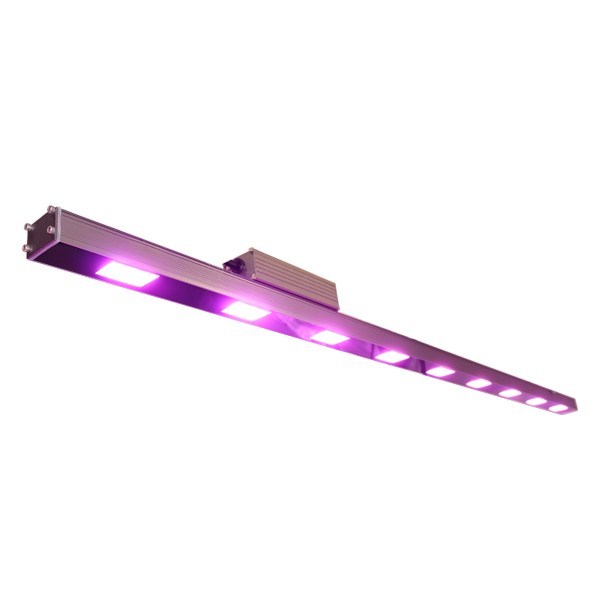
LED grow lights are widly used in plant growing. Since photosynthesis is preferentially driven by specific bands of red and blue light, LEDs offer the opportunity to provide energy of the required wavelengths without wasting any of the output on wavelengths that are not useful for photosynthesis. In theory at least, this should make red, blue or red blue led grow lights less expensive than white LED lights because additional steps have to be taken to get an LED device to emit white light.
Red LEDs
The red LED occupies a special place in the history of LED. Before the invention of LEDs in 1962, other LEDs under study emitted light that was invisible to the human eye (eg in the infrared range). It was Nick Holonyak (Jr.) who proposed a method for synthesizing gallium arsenide phosphide, which is the first useful visible light LED. Even so, red LEDs were initially largely scientific curiosity and research topics due to their high costs (hundreds of dollars each), and LEDs have not reached an economically feasible price point in the past decade.
Plants like red light with a wavelength of about 640 to 675 nanometers (nm). As it happens, LEDs with this range of output are readily available, and in particular there are two very suitable for growing lighting applications. They are super red light (660 nm) made of gallium aluminum arsenide, and high-efficiency red light (635 nm) made of gallium arsenide and gallium phosphide.
Arsenic and arsenide-sounds dangerous, doesn’t it? Yes, arsenic is a toxic substance, but in LEDs, arsenic exists in a small amount of stable solid form, and even if it is discarded in a landfill, it will not pose an environmental threat. In addition, you must work very hard to break the LED, so even if the red LED breaks due to some form of accident or abuse, the possibility of arsenic contamination is very small.
Blue LEDs
It turns out that blue LEDs are much harder than red LEDs. The first blue LEDs appeared in the early 1970s, but the output power was very low. The commercial blue light didn’t appear until 1989. Then, in the 1990s, with the introduction of high-power blue LEDs, these lights revolutionized in Japan.
Plants absorb blue light in the range of about 400 to 450 nm. One type of LED is particularly suitable for meeting these wavelength requirements: ultra-blue light (430 nm), which consists of a substrate made of semiconductor materials such as silicon carbide and gallium nitride.
Red Blue LED GrowLights
So, does it make sense to construct a luminaire that only contains a combination of red and blue LEDs? You bet a series of red and blue LEDs are provided in both round and rectangular panels. These LEDs can be hung above the plant or mounted on the wall. Some of them contain separate controls for manually adjusting the output ratio of red light to blue light. There are also some compact bulb-shaped products that can be screwed into a standard Edison base.
A large number of blue and red LED grow lights can replace high intensity discharge (HID) lamps and fluorescent lamps. Although the electroluminescence process itself does not generate much heat, the electrical energy used for this purpose does heat the LED base, and when these bases are put together, it generates enough heat, so a cooling fan is required. Fortunately, most of the heating takes place on the back of the lamp, so the LED lamp can still be closer to the plant than the HID lamp. You can also place smaller LED lights under the top of the plant canopy and directly between the plants to provide light to the lower leaves.
What will the red blue led grow lights bring in the future? Well, an interesting idea is to produce a lamp whose red/blue ratio changes over time under computer control. This lamp will be similar to the lamp that has been produced that combines two colors, except that the circuits used to control the red and blue outputs will be automatically controlled by the computer. Why is this ideal? Well, many plants adjust their flowering and fruiting cycles based on the ratio of red light to blue light.
As summer ends, the relative amount of red light received by nature tends to increase. Many plants have evolved to use this phenomenon as a signal to switch from a vegetative growth mode to a reproduction mode. Therefore, it is conceivable that automatically imitating this gradually changing lamp over time can improve the growth performance of crops by placing plants in a more natural light environment.
Through further research, it may even be found that changing the ratio of red to blue during the day to simulate sunrise and sunset may have a beneficial effect on the growth of certain crops.
In addition, the use of wavelengths not directly related to photosynthesis (such as far-red or ultraviolet) may have an ideal effect on the growth process of plants. Therefore, even if LED does not play a direct role in these aspects of plant physiology in actual agricultural practice, it may also play a role in research.
VANQ LED has 10-years experience on LED grow lights, we have T8 red blue grow lights, waterproof linear led grow light and 600 cob led grow light for cannabis cultivation. We also provide customized service on LED grow light (OEM, ODM are available) .























